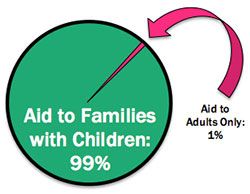Many of us have either needed government aid or will before we die. Excluding programs such as Medicare, Social Security, unemployment and disability and restricting analysis only to means tested programs like TANF, food stamps, Medicaid and public housing, 64% of Americans will rely on government aid at some point in their lifetimes. The idea that public assistance is for some “other” group of people unlike anyone we know is simply not true except for the most privileged. That said, public assistance is needed by some groups more than others.1
The face of welfare has changed over the years. One constant has been the focus on helping children. This fact remains true today: most aid overall is for children, with food stamps as the one exception. Even so, a full 99% of TANF, food stamps, and SSI benefits together go to families with children.
 Until recently, the most numerous adult recipients were white women, heading households with two children.2 Today, women remain the primary recipients of aid—mostly because they are the primary caregivers for children. However, ethnically, this profile is changing. In sheer numbers, public assistance is almost evenly distributed among White, Black and Hispanic families.3 These numbers are somewhat misleading, however, because of the different percentages of each ethnic group in the United States. 9.5% of all Whites in the U.S. receive assistance, 34% of Blacks and 28% of Hispanics. In other words, ethnic minorities are disproportionately represented on the welfare rolls. As one would expect, they are also disproportionately poor. The question is, why?
Until recently, the most numerous adult recipients were white women, heading households with two children.2 Today, women remain the primary recipients of aid—mostly because they are the primary caregivers for children. However, ethnically, this profile is changing. In sheer numbers, public assistance is almost evenly distributed among White, Black and Hispanic families.3 These numbers are somewhat misleading, however, because of the different percentages of each ethnic group in the United States. 9.5% of all Whites in the U.S. receive assistance, 34% of Blacks and 28% of Hispanics. In other words, ethnic minorities are disproportionately represented on the welfare rolls. As one would expect, they are also disproportionately poor. The question is, why?
Research makes it abundantly clear that no ethnic group is more or less capable or intelligent than any other. In other words, individuals no matter their ethnicity are equally capable of success if structural barriers are removed. That is a mighty big “if” however, and can only be understood when we address how the major causes of poverty impact ethnic minorities more severely due to historical and systemic inequalities.
Sources 1 Handler, Joel F., and Yeheskel Hasenfeld. 2007, pp. 134. Blame Welfare, Ignore Poverty and Inequality. New York: Cambridge University Press. 2 See for example stats from the National Survey of America’s Families (NSAF) reported in Zedlewski and Alderson 2001; online at http://www.urban.org/publications/310298.html). See also the “Characteristics and Financial Circumstances of TANF Recipients” reports produced by the U.S. Department of Health and Human Services, Office of Family Assistance that provides annual reports. Search according to year at their site: http://www.acf.hhs.gov/. 3 Table A: Trend in TANF Families by Race/Ethnicity FY2000 – FY2010 in “Characteristics and Financial Circumstances of TANF Recipients, Fiscal Year 2010” published by the US Department of Health and Human Services, Office of Family Assistance. Online at: http://www.acf.hhs.gov/programs/ofa/resource/character/fy2010/fy2010-chap10-ys-final. See also Table 8, Characteristics and Financial Circumstances of TANF Recipients, Fiscal Year 2009, US Dept. Health and Human Services for TANF percentages as opposed to welfare more generally.


